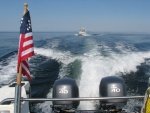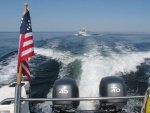jlastofka
New member
- Joined
- Jun 9, 2007
- Messages
- 254
- Reaction score
- 0
- C Dory Year
- 2007
- C Dory Model
- 22 Cruiser
- Hull Identification Number
- CDO22681C708
- Vessel Name
- Bossa Nova
On a whim today I tried using my 90 main and Hi thrust 9.9 kicker on my 22 cruiser to do the "big boat twin engine" maneuvering we all see around some slips and docks. To my pleasant surprise, it worked quite well, even though the engines are quite different and mounted very close together.
At very low speed, the Hi thrust kicker is similar to the main in terms of thrust vs throttle lever movement. I found it pretty easy to put one in forward and one in reverse and control the boat's turning rate by increasing or decreasing the spread between the two throttle settings. By moving both throttles forward or backward a little I could move the boat forward or backward while it was spinning in more or less one spot.
I'd never tried this before with any boat, but it seemed intuitive right from the start. I motored down the fairway between slips in front of the yacht club and spun the boat a couple times and parked alongside a dock, all without touching the steering wheel. I'd only been practicing about 10 minutes before trying this stunt in front of some friends. Too much fun....
I don't think I'll fire up the kicker every time I'm about to dock, but it's nice to have this technique waiting in the wings in case I need to use it.
Jeff
At very low speed, the Hi thrust kicker is similar to the main in terms of thrust vs throttle lever movement. I found it pretty easy to put one in forward and one in reverse and control the boat's turning rate by increasing or decreasing the spread between the two throttle settings. By moving both throttles forward or backward a little I could move the boat forward or backward while it was spinning in more or less one spot.
I'd never tried this before with any boat, but it seemed intuitive right from the start. I motored down the fairway between slips in front of the yacht club and spun the boat a couple times and parked alongside a dock, all without touching the steering wheel. I'd only been practicing about 10 minutes before trying this stunt in front of some friends. Too much fun....
I don't think I'll fire up the kicker every time I'm about to dock, but it's nice to have this technique waiting in the wings in case I need to use it.
Jeff


